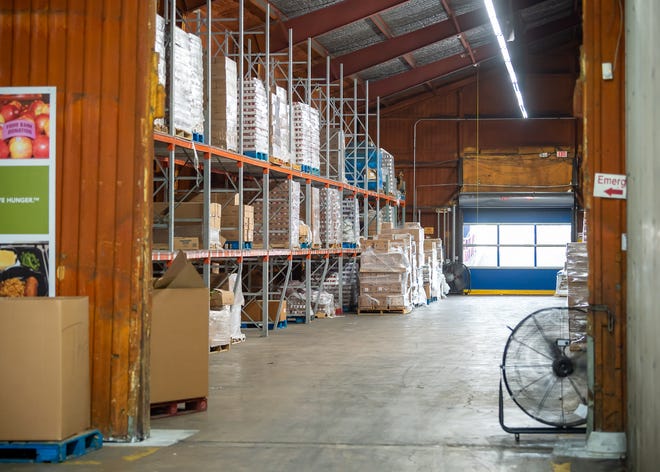[ad_1]
Lights come on in a large warehouse around 6 a.m. daily. Each morning workers and forklift operators prepare to load trucks with palettes of food headed to dozens of food banks across the area. Over 400 thousand pounds of food leaves the facility a week but, that is just a small part of what they do.
Second Harvest Food Bank is one of five Feeding Louisiana food banks in the state. The organization serves 23 parishes in South Louisiana operating out of two main facilities in New Orleans and Lafayette. Lafayette’s branch serves 12 parishes including all of Acadiana to Lake Charles and Cameron Parish, communication specialist for Second Harvest Natasha Curley explains.

“Second Harvest is the largest food bank in the state,” she said “The Lafayette location opened in 2006 as a response to Hurricane Katrina. We are an anti-hunger organization. We say anti-hunger— definitely approaching the hunger issues from a holistic approach. That means we’re making sure we’re providing food access, as well as education, as well as advocacy.
“When we said advocacy, we’re talking about going to making petitions, going to our leaders and officials and getting the policies in place. We have our ears to the ground, making sure we’re letting them know, ‘Here’s the need, and here’s what you can do.’
Meeting hunger at its root

Across the eight parishes in Acadiana, an average of 24% of children and over 100,000 residents faced food insecurity prior to the pandemic. Second Harvest has developed programs to meet hunger at its root cause.
“Food insecurity is normally not a stand-alone issue,” Brittany Bowie Impact Operations Officer explains. “A majority of the time, people who are food insecure, are also suffering other aspects of their lives. There is a stigma on needing help from pantries and food banks but we fail to realize a lot of people around us are on the brink of food insecurity.”
“Sometimes people may really want help but they have so much going on that they can’t figure out the first step. So our first step is always ‘well, let’s get something. Let’s get you some food.’ And then the second step is figuring out what else can we (do to) help you.”
The U.S. Department of Agriculture defines food insecurity as a lack of consistent access to enough food for an active, healthy life. The USDA reported that 13.8 million people were food insecure in 2020. Food insecurity can take many forms some common examples Second Harvest provided include
- A child going without meals during the summers when school is not in session
- A senior living on a fixed income having to choose between groceries and medicine
- Buying the cheapest food available, even if it is not the healthiest to save money
- A college student working to afford school and cutting their grocery budget to afford other needs.
One in four adults in Louisiana faces some form of food insecurity and the statistics are slightly higher for children and elders. Second Harvest saw and felt the need for varied forms of help and is actively finding new ways to aid.
With 68 partnering pantries in Acadiana, they are able to point people to help no matter where theyare located. On top of traditional pantries, they have begun adding food pantries into schools across the area to help tackle childhood hunger. Daily meal delivery, mobile pantries, and discounted mobile markets are some of the programs offered through Second Harvest and their partners.

Regional Director Paul Scelfo said the group is working on a new program called Groceries on the Geaux to help seniors who are either food insecure and living on a fixed income or have a lack of transportation.
“Brittany is working on another program right now called our Geriatric Senior Program [Groceries on the Geaux] with the Ochsner,” Scelfo says. “Focusing on something I would have never realized before working with seniors who have experienced food insecurity.
“They’re in the hospital, when they come home, they might not have any food to eat, and doctors are saying ‘You’re on bed rest for two weeks.’ So if they don’t have any help, what’s happening is when a nurse comes in and checks on him, they’re dehydrated, and they’re hungry. And they have to check them right back in the hospital, just to get them nourished.”
“Now, when they leave the hospital, they’re taking food with them for about five days. Then we’re able to contact them and reach out to them through a food delivery program like Meals on Wheels, Beacon Group, and even what we [Second Harvest] are able to do to reach out to them and sustain them. With ready-to-eat meals, once they’re at their home, trying to keep them from being readmitted to the hospital.”
This is a community effort
Being able to provide millions of meals throughout
the year is no small feat and it is impossible without the help of the community. Second Harvest is always in need of volunteers and donations, especially now as they prepare for hurricane season across the state.
Related:What should you do to prepare your business for hurricane season?
“We are always looking for people who want to help,” Curley says excitedly. ” We have a volunteer activity every weekday, Thursdays are reserved for large groups. We have groups of volunteers in here from all different walks of life, helping us sort and repack donations.”

Volunteers work in three-hour shifts where on average they are able to prepare 240 weeks’ worth of food. This food not only helps those regularly affected by lack of food but those displaced by floods, hurricanes, fire, domestic abuse, and more.
Monetary donations are also extremely useful, most people will never experience poverty or food insecurity. According to their website, 97 cents of every dollar donated goes directly to programs that feed the hungry. One dollar is able to provide four meals through the food bank. They also accept donations of food, diapers, formula, and more.
If you are in need of assistance you can visit no-hunger.org/foodassistance to find the program or pantry nearest you. You can also visit Second Harvest at 215 East Pinhook Rd. in Lafayette for immediate assistance. If you wantto donate or volunteer visit no-hunger.org/ways-give
Connect with WaTeasa Freeman by email [email protected], Twitter @wateasaf TikTok @theadvertisereats
[ad_2]
Source link






